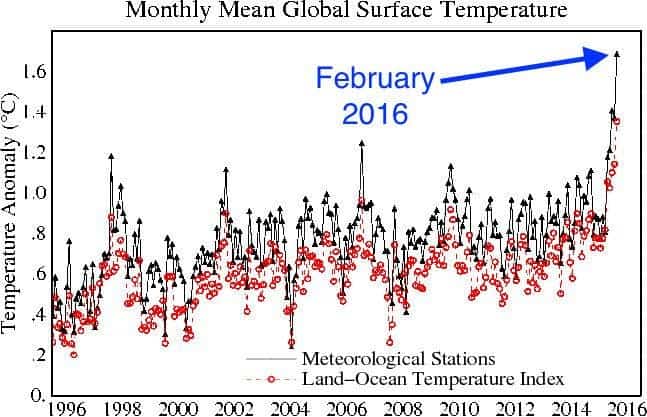It’s easy to understand why climate change deniers want to cut NASA’s climate research funding – because it keeps proving them wrong. February was the most unusually warm month in recorded history, smashing the previous record set just one month before, in January.
This January was the warmest January on record, but that’s not an isolated event. According to preliminary information released by NASA, February had a global average surface temperature of 1.35 degrees Celsius above the 1951 to 1980 average, or 2.43 degrees Fahrenheit above average. This means that the heat anomaly is larger than ever before, at least in observed history. January was 1.14 degrees Celsius above average, or 2.3 degrees Fahrenheit, compared to the same period.
A very strong El Niño exacerbated the high temperatures, but the real blame is caried by humans. Kevin Trenberth, a senior climate scientist at the National Center for Atmospheric Research in Boulder, Colorado told Mashable that El Niño likely accounted for about 0.15 degrees Celsius, or 0.27 degrees Fahrenheit – only a fraction of the total temperature rise.
“The increase in ocean heat content is relentless and provides the memory of global climate change and Earth’s energy imbalance,” Trenberth said.
The reaction of Gavin Schmidt, the director of NASA’s Goddard Institute for Space Studies (GISS), who helps conduct these analyses is very telling:
Updates for February in @NASAGISS temperature analysis. Wow. pic.twitter.com/4YOJLjeZ5h
— Gavin Schmidt (@ClimateOfGavin) March 12, 2016
Similar results were reported by other research institutes. The University of Alabama at Huntsville reported a global average temperature that was 0.83 degrees Celsius, or 1.5 degrees Fahrenheit, above average during the month of February. It’s important to note that global warming isn’t felt uniformly across the planet – some areas experience much more drastic warming than others. The Arctic areas are especially threatened. Furthermore, global warming doesn’t happen completely gradually. There are spikes and dips associated with either global or localized phenomena. So while February’s record is extremely telling, it’s not what happened in these 29 days that matters – it’s the overall trend of massive warming. No matter how you look at it, be it a 5-year average or a 30-year trend, the result is the same: our planet is heating up drastically, and it’s because of us.











